- The US Dollar Index finished the week deeply in the red.
- Trump's “Liberation Day” rippled across the globe.
- Next of note on the US calendar will be the Inflation Rate.
After a forgettable week, the US Dollar (USD) lost its grip, adding to the previous decline and succumbing to the sharp selling pressure that eventually sent the US Dollar Index (DXY) to the 101.30-101.20 band for the first time since early October 2024.
The steep decline in the index gathered renewed and firm pace after President Donald Trump unveiled his so-called “Liberation Day” on Wednesday, which has also reinforced the prospects of a transatlantic trade war and has lent extra legs to the idea of a US economic slowdown.
The Greenback’s intense move lower came in tandem with the equally pronounced retracement in US Treasury yields across various time frames.
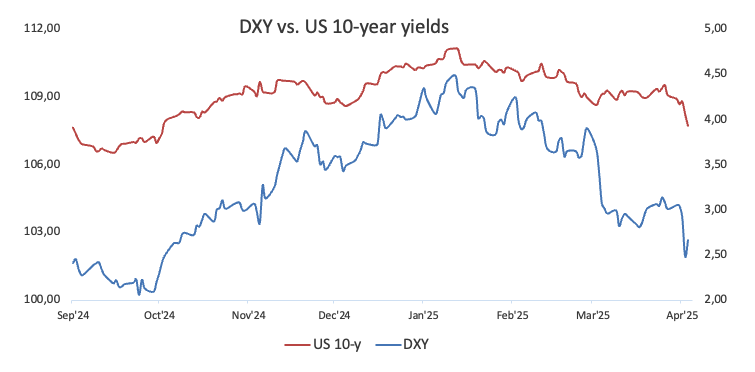
Winds of change: Confronting trade turbulence and escalating prices
In a game-changing move, the United States unveiled its “Reciprocal Tariff to Rectify Trade Practices” plan on Wednesday.
Under this new policy, a baseline 10% tariff will apply to all imports, with additional country-specific surcharges ranging from 10% to 50%. That said, China faces a steep 34% levy on top of its existing 20% duty, while the European Union (EU) is subject to 20%, the UK to 10%, and Japan to 24%. The baseline tariffs will come into effect this Saturday, with the extra “reciprocal” rates following on April 9.
In addition, Mexico and Canada remain exempt from these reciprocal tariffs for now, thanks to a standing 25% blanket levy on any US imports not covered by the United States-Mexico-Canada Agreement (USMCA). Cars, auto parts, steel, and aluminum also stay in the clear, as they’re already taxed at 25%.
Although China, the EU, and several other countries have vowed to fight back, US Treasury Secretary Scott Bessent issued a stark warning: “I wouldn’t try to retaliate… As long as you don’t retaliate, this is the high end of the number.”
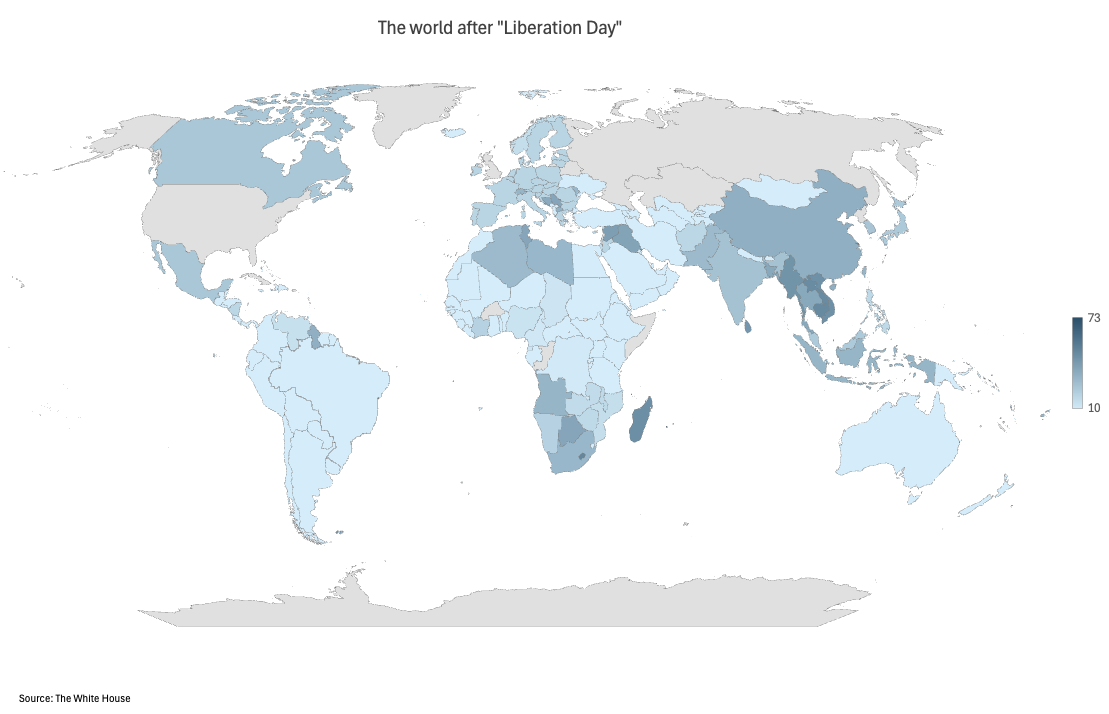
So, what’s the reasoning behind tariffs? Initially, higher import duties tend to trigger a short-lived spike in consumer prices—a one-time shock that’s unlikely to immediately force the Federal Reserve’s (Fed) hand. However, if these tariffs stick around or escalate, businesses might have little choice but to keep prices elevated, whether because competition dwindles or they seek larger margins.
This second wave of price hikes could eventually slow consumer spending, dampen economic growth, hit employment, and even revive deflationary risks. Over time, these cascading effects might push the Fed toward more forceful policy measures.
Steering through economic deceleration and rising inflation
The increasing weakness surrounding the US Dollar has been spurred by growing speculation of an economic slowdown, fueled by newly announced tariffs, tepid results from US fundamentals, and eroding market confidence.
While inflation still runs above the Fed’s 2% target—evident in both CPI and PCE figures—a resilient and robust labor market adds an intriguing twist to the story.
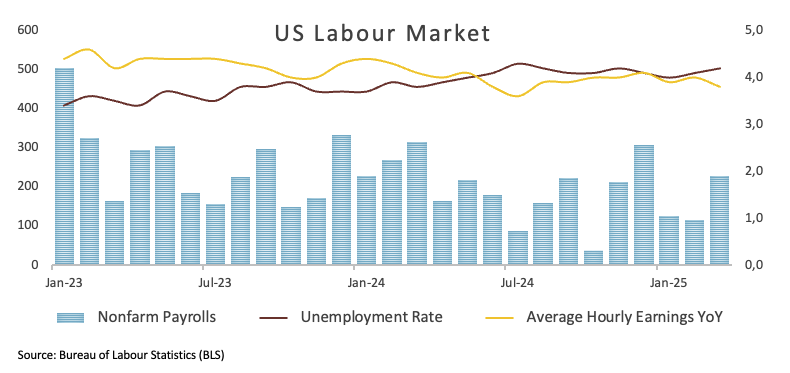
In the end, this blend of factors, combined with rising uncertainty over the impact of US tariffs both domestically and overseas, is expected to maintain the volatility in the Greenback, leaving conditions anything but mitigated.
Measured moves: The Fed’s prudent response to market uncertainty
On March 19, the Federal Reserve wrapped up its meeting by keeping the federal funds rate anchored between 4.25% and 4.5%.
Citing heightened uncertainty—from shifting policies to rising trade tensions—the Committee opted for a cautious stance. At the same time, it revised its 2025 forecasts, lowering real GDP growth from 2.1% to 1.7% and nudging inflation expectations up from 2.5% to 2.7%. These adjustments highlight growing worries about a stagflation threat, where slow growth intersects with higher inflation.
During his customary press conference, Fed Chair Jerome Powell reiterated that there is no immediate need for additional rate cuts.
In a flurry of insights from top Federal Reserve officials, policymakers painted a picture of cautious optimism amid mounting economic risks.
That said, New York Fed President John Williams noted that policy is "well positioned" and "moderately restrictive," allowing for careful data monitoring before any rate changes.
Richmond Fed President Thomas Barkin and Chicago Fed President Austan Goolsbee both highlighted inflation risks from tariffs, with Barkin emphasizing that rate cuts would depend on inflation trends and Goolsbee warning that new tariffs could spark renewed inflation or slow growth.
Fed Governor Adriana Kugler and Vice Chair Philip Jefferson also stressed that until inflation risks subside, keeping rates steady is the prudent course of action, while Fed Governor Lisa Cook urged the Fed to wait and watch emerging data before making further adjustments.
In addition, Federal Reserve Chair Jerome Powell warned on Friday that President Donald Trump's new tariffs are "larger than expected," and he predicted that the resulting economic fallout—including higher inflation and slower growth—will likely be just as significant. He remarked, "We face a highly uncertain outlook with elevated risks of both higher unemployment and higher inflation," a scenario that could jeopardise the Fed's twin mandates of 2% inflation and maximum employment. He emphasised that while it isn’t the Fed's role to critique the Trump administration's policies, its duty is to react to their impact on an economy that, only weeks ago, was enjoying a "sweet spot" of falling inflation and low unemployment
The road ahead for the Greenback
Next week, all eyes will be on the release of the US Inflation Rate figures and the unveiling of the FOMC Minutes from the March 18-19 meeting. Fed officials are also expected to offer some spirited commentary that could add an exciting twist to the unfolding economic narrative.
Charting the US Dollar Index
The US Dollar Index (DXY) remains technically under heavy pressure, trading below its key 200-day Simple Moving Average (SMA) of 104.86, which underscores a bearish sentiment.
The downward bias accelerated this week, prompting DXY to now face its immediate support at its 2025 floor of 101.26 (April 3) and further down at the 2024 trough of 100.15 (September 27), just shy of the crucial 100.00 level.
On the other hand, a much-needed rebound could push the index back to last week's high of 104.68 (March 26) before testing the 200-day SMA. Beyond that, the next hurdles are the provisional 55-day and 100-day SMAs at 105.91 and 106.63, respectively, seconded by the weekly high of 107.66 (February 28), the February peak of 109.88 (February 3), and ultimately the 2025 top of 110.17 (January 13).
Meanwhile, momentum indicators do not rule out further retracements in the near term: the daily Relative Strength Index (RSI) has rebounded to the area above 34, while the Average Directional Index (ADX) has advanced to approximately 34, suggesting that the current trend may be gaining some steam.
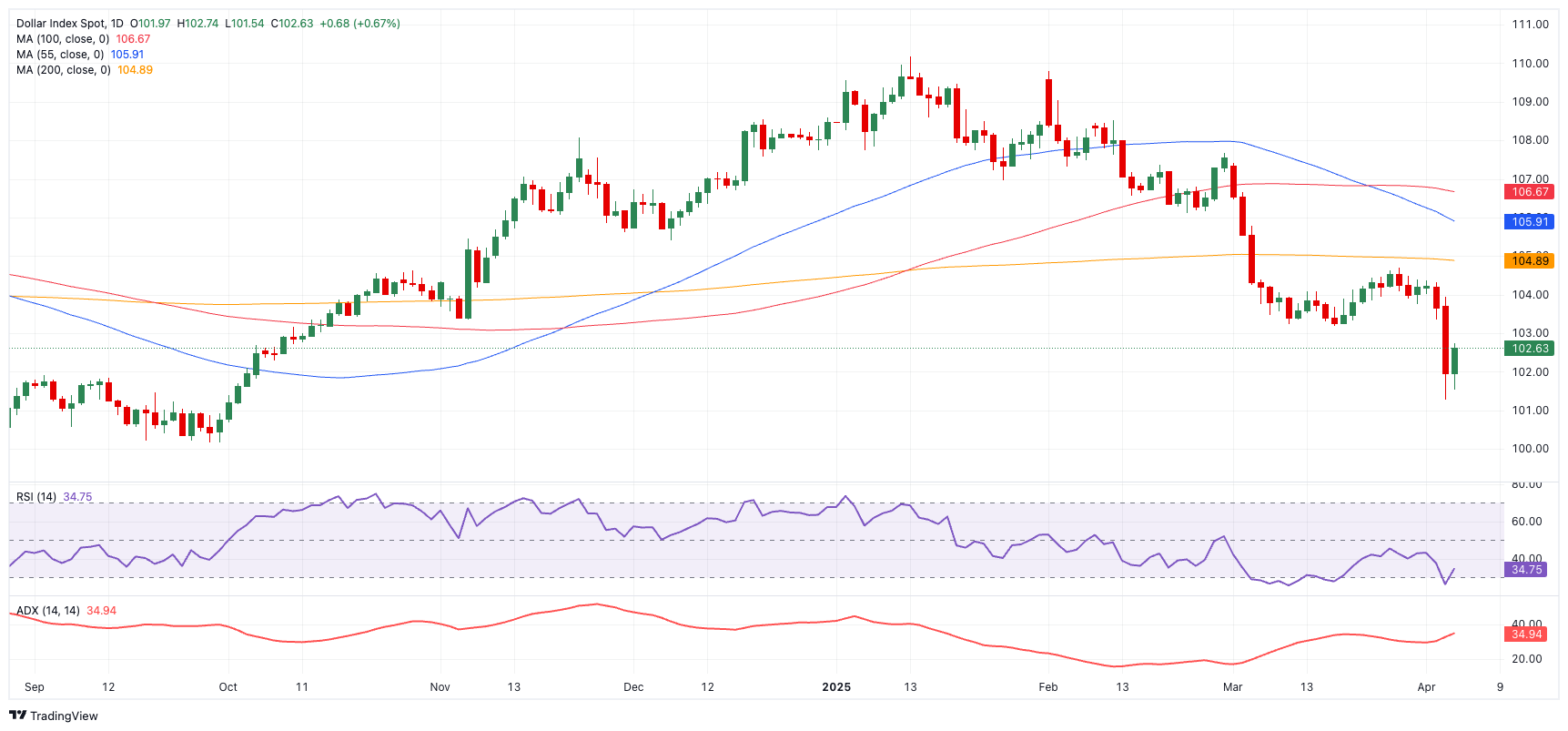
Inflation FAQs
Inflation measures the rise in the price of a representative basket of goods and services. Headline inflation is usually expressed as a percentage change on a month-on-month (MoM) and year-on-year (YoY) basis. Core inflation excludes more volatile elements such as food and fuel which can fluctuate because of geopolitical and seasonal factors. Core inflation is the figure economists focus on and is the level targeted by central banks, which are mandated to keep inflation at a manageable level, usually around 2%.
The Consumer Price Index (CPI) measures the change in prices of a basket of goods and services over a period of time. It is usually expressed as a percentage change on a month-on-month (MoM) and year-on-year (YoY) basis. Core CPI is the figure targeted by central banks as it excludes volatile food and fuel inputs. When Core CPI rises above 2% it usually results in higher interest rates and vice versa when it falls below 2%. Since higher interest rates are positive for a currency, higher inflation usually results in a stronger currency. The opposite is true when inflation falls.
Although it may seem counter-intuitive, high inflation in a country pushes up the value of its currency and vice versa for lower inflation. This is because the central bank will normally raise interest rates to combat the higher inflation, which attract more global capital inflows from investors looking for a lucrative place to park their money.
Formerly, Gold was the asset investors turned to in times of high inflation because it preserved its value, and whilst investors will often still buy Gold for its safe-haven properties in times of extreme market turmoil, this is not the case most of the time. This is because when inflation is high, central banks will put up interest rates to combat it. Higher interest rates are negative for Gold because they increase the opportunity-cost of holding Gold vis-a-vis an interest-bearing asset or placing the money in a cash deposit account. On the flipside, lower inflation tends to be positive for Gold as it brings interest rates down, making the bright metal a more viable investment alternative.
Information on these pages contains forward-looking statements that involve risks and uncertainties. Markets and instruments profiled on this page are for informational purposes only and should not in any way come across as a recommendation to buy or sell in these assets. You should do your own thorough research before making any investment decisions. FXStreet does not in any way guarantee that this information is free from mistakes, errors, or material misstatements. It also does not guarantee that this information is of a timely nature. Investing in Open Markets involves a great deal of risk, including the loss of all or a portion of your investment, as well as emotional distress. All risks, losses and costs associated with investing, including total loss of principal, are your responsibility. The views and opinions expressed in this article are those of the authors and do not necessarily reflect the official policy or position of FXStreet nor its advertisers. The author will not be held responsible for information that is found at the end of links posted on this page.
If not otherwise explicitly mentioned in the body of the article, at the time of writing, the author has no position in any stock mentioned in this article and no business relationship with any company mentioned. The author has not received compensation for writing this article, other than from FXStreet.
FXStreet and the author do not provide personalized recommendations. The author makes no representations as to the accuracy, completeness, or suitability of this information. FXStreet and the author will not be liable for any errors, omissions or any losses, injuries or damages arising from this information and its display or use. Errors and omissions excepted.
The author and FXStreet are not registered investment advisors and nothing in this article is intended to be investment advice.
Recommended Content
Editors’ Picks

Gold nears $3,400; fresh record highs and counting amid USD sell-off
Gold price closes in on $3,400 as the record rally regains strength on Easter Monday. Concerns over US-China trade war escalation and the Fed’s independence smash the US Dollar to three-year troughs. RSI stays overbought on the daily chart, with thin volumes likely to exaggerate moves in Gold price.

EUR/USD trades with sizeable gains above 1.1500, at over three-year highs
EUR/USD trades over 1% higher so far this Monday as the relentless selling interest in the US Dollar keeps it well above the 1.1500 threshold - the highest level since November 2021. Growing concerns over a US economic recession and the Federal Reserve’s autonomy continue to exert downward pressure on the USD.

GBP/USD stays strongly bid near 1.3400 on intense US Dollar weakness
GBP/USD continues its winning streak that began on April 8, trading close to 1.3400 in early Europe on Monday. The extended US Dollar weakness, amid US-Sino trade war-led recession fears and heightened threat to the Fed's independence, continue to underpin the pair. Thin trading is set to extend.
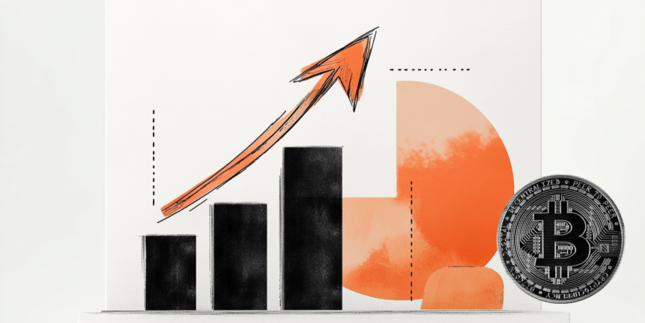
How to make sense of crypto recovery – Is it a buy or fakeout
Bitcoin (BTC), Ethereum (ETH) and XRP, the top three cryptocurrencies by market capitalization, extend their last week’s recovery on Monday, even as trader sentiment is hurt by the US President Donald Trump’s tariff policy and announcements.

Five fundamentals for the week: Traders confront the trade war, important surveys, key Fed speech Premium
Will the US strike a trade deal with Japan? That would be positive progress. However, recent developments are not that positive, and there's only one certainty: headlines will dominate markets. Fresh US economic data is also of interest.

The Best brokers to trade EUR/USD
SPONSORED Discover the top brokers for trading EUR/USD in 2025. Our list features brokers with competitive spreads, fast execution, and powerful platforms. Whether you're a beginner or an expert, find the right partner to navigate the dynamic Forex market.